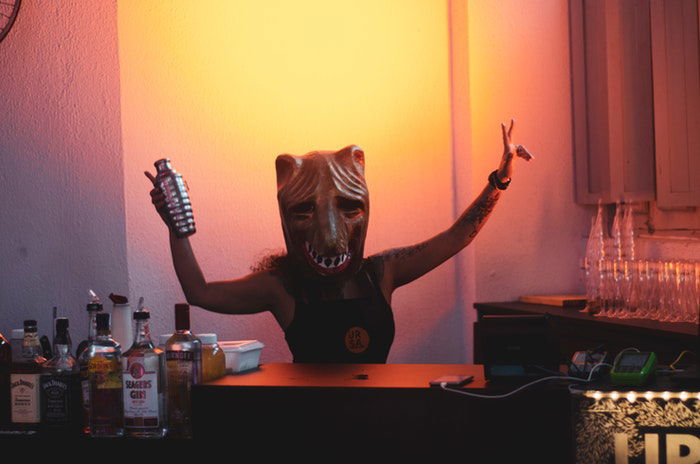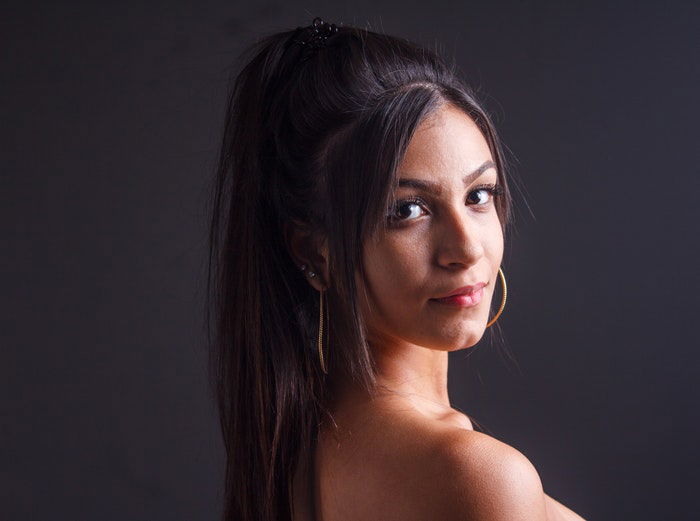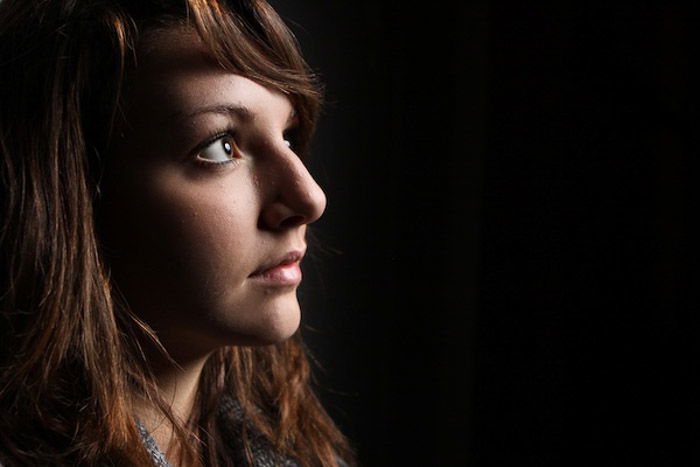How to Shoot Boudoir Self Portraits (Classy and Beautiful)
Boudoir photography doesn’t always mean taking photos of your clients. You can also take self-portrait boudoir photography. This will help you keep your skills sharp and give you a great boost of personal confidence!
How to Shoot Boudoir Self Portraits
Here are some answers to common questions about boudoir self portraits with some easy-to-follow tips on how to take them.
1. What Are Boudoir Self Portraits?
Due to the difficult nature of self-portraits, many photographers shy away from the idea. This type of photography can be very beneficial to you and your company.
Self-portraits are not about vanity or attention-seeking. They are a way to put yourself in your client’s shoes. And they also give you the freedom to try out new ideas.
Photographing yourself helps you learn lighting techniques and poses without hiring a model. It can also be therapeutic for creativity.
I contacted Beth Claire of Lost Highway Imaging, one of the best self-portrait photographers in the industry, for her top tips.
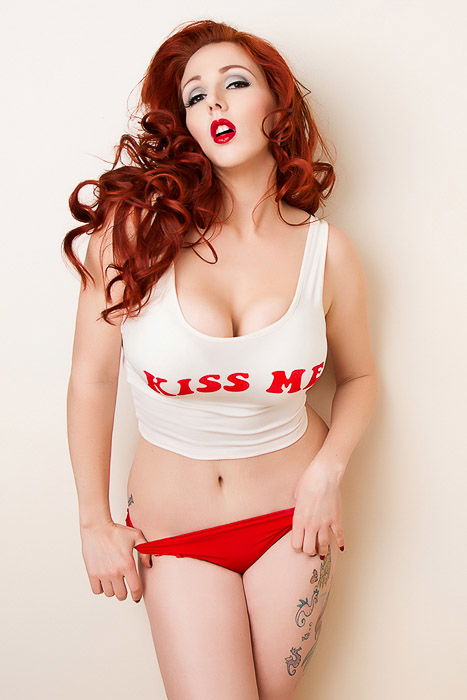
© Beth Claire
2. Overcoming Common Boudoir Self Portrait Challenges
The first time you attempt a self-portrait, whether boudoir or not, it is important to clear your day. It is more time-consuming than you might expect. And you want to give yourself space to not feel rushed.
Checking on the clock will only add to the stress. If you are not experienced with hair and makeup, you may want to hire an artist. This will give you the full effect that your boudoir clients would receive. Why not pamper yourself for the day?
Doing a dry run without a stylist is important so the pressure is not on you the day of your styled shoot.
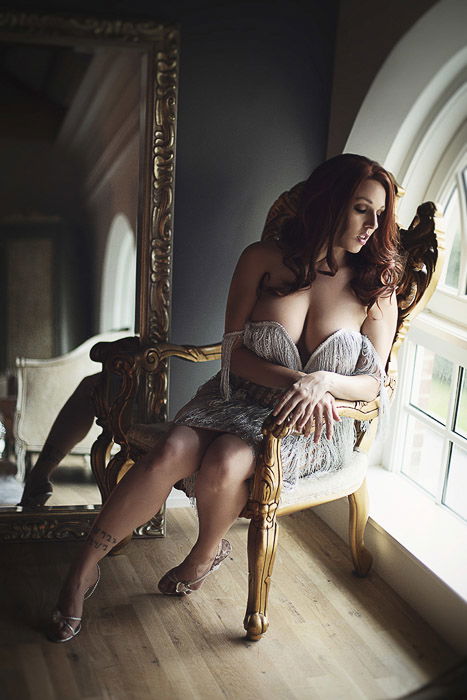
© Beth Claire
Claire suggests using a tripod versus propping your camera on a bench or dresser table. It is easier to keep the frame stable, and you will have more flexibility in where you are shooting.
In the past, I have attempted to put my camera on a table or chair. But it never had the stability for framing the area as my tripod. A big part of boudoir self portraits is having patience.
It will take practice to get your focus right, so take your time to avoid frustration.
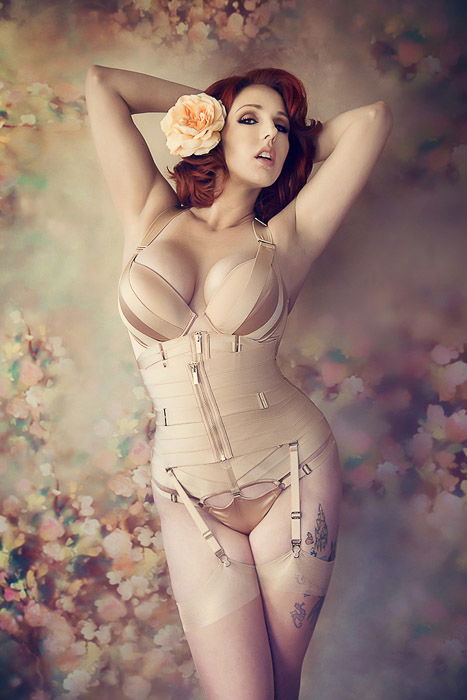
© Beth Claire
Changing up posing will allow you to show movement and fluidity in your posts.
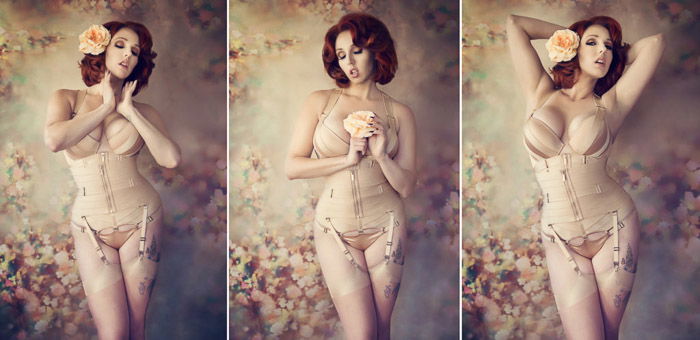
© Beth Claire
3. Equipment for Self-Portrait Boudoir Photography
Before you begin, you should see what studio equipment you have to work with for the photoshoot. I have tried using the timer on my camera. But I recommend a remote or something similar.
The back and forth will indeed lead to a cardio workout. The exhaustion will show in your images.
Claire uses a CamRanger unit. She prefers this since she can often select the focus point directly on the screen of her device.
She has used a remote and intervalometer in the past. Remember, if you use a push-button remote, you must hide it in one of your hands. Some cameras do have built-in intervalometers. Before you start, you will want to check your manual.
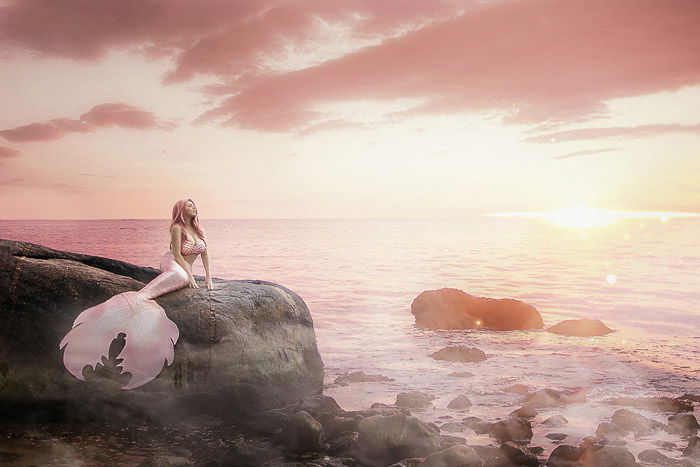
© Beth Claire
If you’re setting up images on location, such as at the beach, ask an assistant to accompany you. In the image above, Claire created her own silicone mermaid tail.
Silicone tails are difficult to get into. Jumping down off the rocks to readjust in case of a tripod fall would be difficult. Having an assistant to sit with your camera when you are in a themed setup will help.
Use boudoir props such as mirrors and textured wardrobes such as this robe to help give your portrait an advantage. In this image, Claire can add drama all while hiding any remote or trigger in her shot.
Setups do not have to be difficult or time-consuming. A robe, a mirror, and a strobe gave Claire all she needed to capture this dramatic portrait.
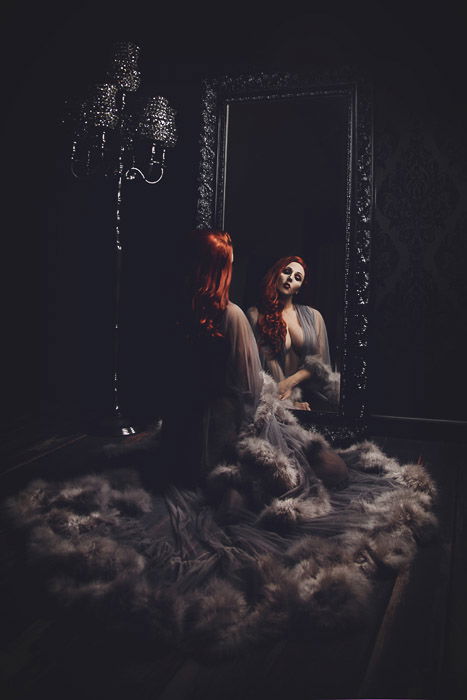
© Beth Claire
Focusing is probably the most difficult aspect of self-portraits. Placing a mannequin or other object in the spot can be helpful if you are looking for a specific depth of field. This will give you something to focus on before you step into the frame. She even suggests using kids’ toys for a stand-in model.
When shooting on a bed, you can use brightly colored tape to create an “X” for a focal point. If a stand-in is not an option, giving yourself a little more depth of field than you would normally shoot is important.
Until Claire gained more self-portrait experience, she started with an aperture of f/5.6. She now shoots reliably at f/1.8 without any issues. In the beginning, it was helpful to have this wiggle room in case the focus was not perfect.
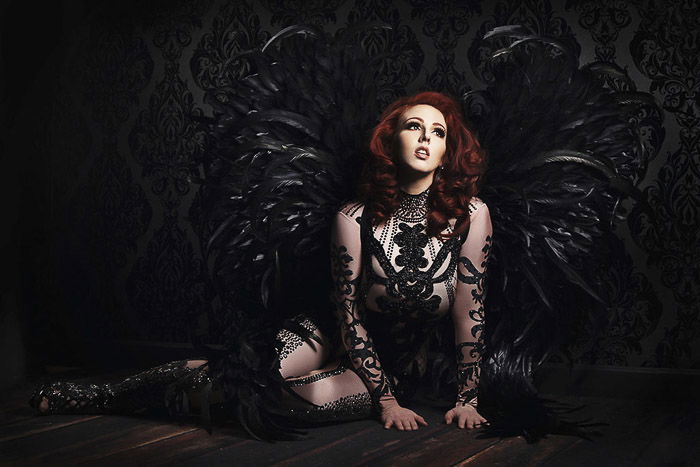
© Beth Claire
4. Choosing Your Boudoir Self Portrait Wardrobe
It is important to choose a wardrobe that makes the storyline come alive. And that also makes you feel good. You will most likely be alone during your self-portraits, so choose pieces you do not need assistance with.
Unless you have a friend nearby, lacing up a corset may be too difficult and frustrating for the first time. Choose items that make sense to you instead of what you feel would be more acceptable.
If you are more into Calvin Klein underwear, use this. Don’t struggle with a bodysuit that is itchy and uncomfortable.
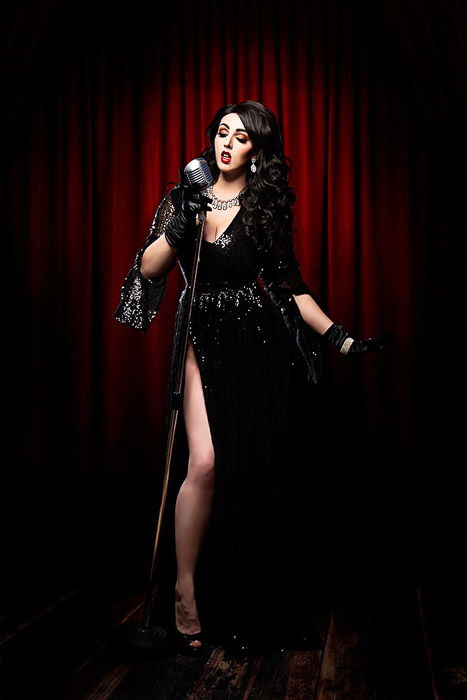
© Beth Claire
5. Selecting Boudoir Self Portrait Images
Unlike a boudoir client session, self-portraits may not produce as many usable shots. Expect to take twenty to thirty shots to get one that works. This is mostly true at the start of your self-portrait career.
Plan to walk away with one or two great shots the first time around rather than trying to fill an album. The intent for this is to practice until you get the hang of your style in this new genre.
If you are nervous about lighting or posing, it may help to pose just as you would with your own clients. Create your posing and lighting flow just as you would with one of your clients during a normal session. This removes the guesswork of lighting and posing. And it creates content for your client group.
It is a great way to blog and interact with your VIP groups. Let them know you put yourself in their shoes. Your clients will appreciate that you understand how nerve-wracking a session can be. And that you can relate.
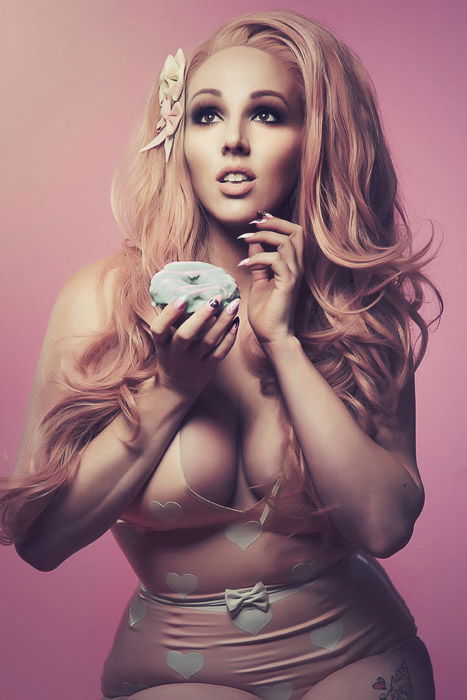
© Beth Claire
6. Getting Creative with Boudoir Self Portraits
The great thing about self-portraits is the freedom of creativity. You are not bound to a specific look, so this is the time to get all those ideas into your camera.
When working with clients, you may be nervous to attempt a new look and waste your client’s time. Hiring models is a great way. But it also costs money for their time. Self-portraits allow adding a new dramatic look, trying out new poses, or even a new style.
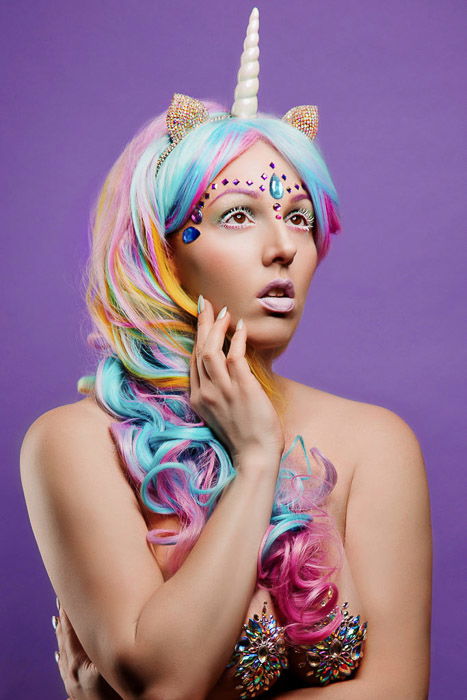
© Beth Claire
Once you get the focus down, you can start playing with other options, like themed styles. Claire creates a shoot with holiday-themed ideas to put to her VIP groups.
This gives her clients a visual of her setups—a Halloween session, for example. Adding strobe lighting gives a dramatic look to your session as well.
You may want to wait on artificial lighting until after a few tries. That way, you are not overdoing it the first time around.
After you gain experience, choose a variety of looks to test out new ideas. If you normally love to shoot in lingerie, choose a themed look next time. You’ll get more diversity in your self-portrait portfolio.
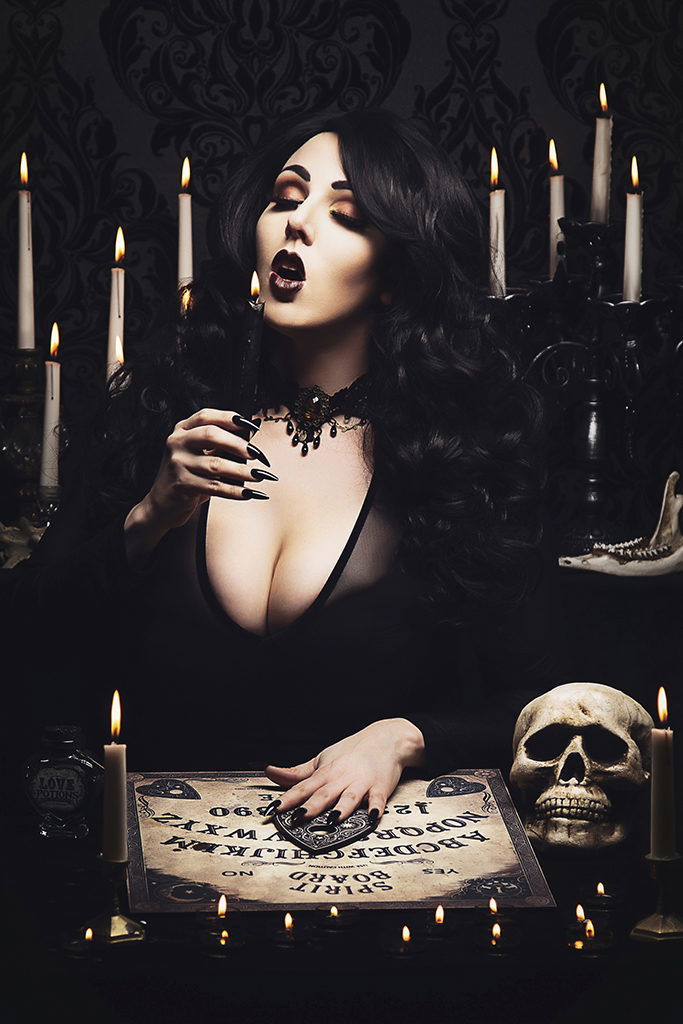
© Beth Claire
7. Avoiding Mistakes During a Boudoir Self Portrait
A common mistake of first-timers is sticking to the same poses and camera angles for the entirety of the shoot. Change it up in each shot to see which you prefer. You would never take 30 shots of your clients in the same pose. Why do this with your own session?
Getting frustrated throughout the shoot if you feel it is not going the way you had intended is another mistake. Take a few deep breaths and walk away for a moment.
This is not a client shoot where the money is on the table. This is for you to challenge your creativity. Unless you are doing a 365-day photo challenge, you will have plenty of time to get it right.
Another mistake is being judgmental of yourself. Boudoir self portraits take time and patience to learn. Your first attempt may, in your mind, be a failure. But it is just a stepping stone to the next session.
It is important to be kind to yourself during a self-portrait photography session. This kindness applies to every step of the process, from getting dressed to reviewing the back of your camera.
During the session, take a step back and look at yourself the way you would your clients. Why judge yourself if you don’t judge them for stretch marks, cellulite, or weight?
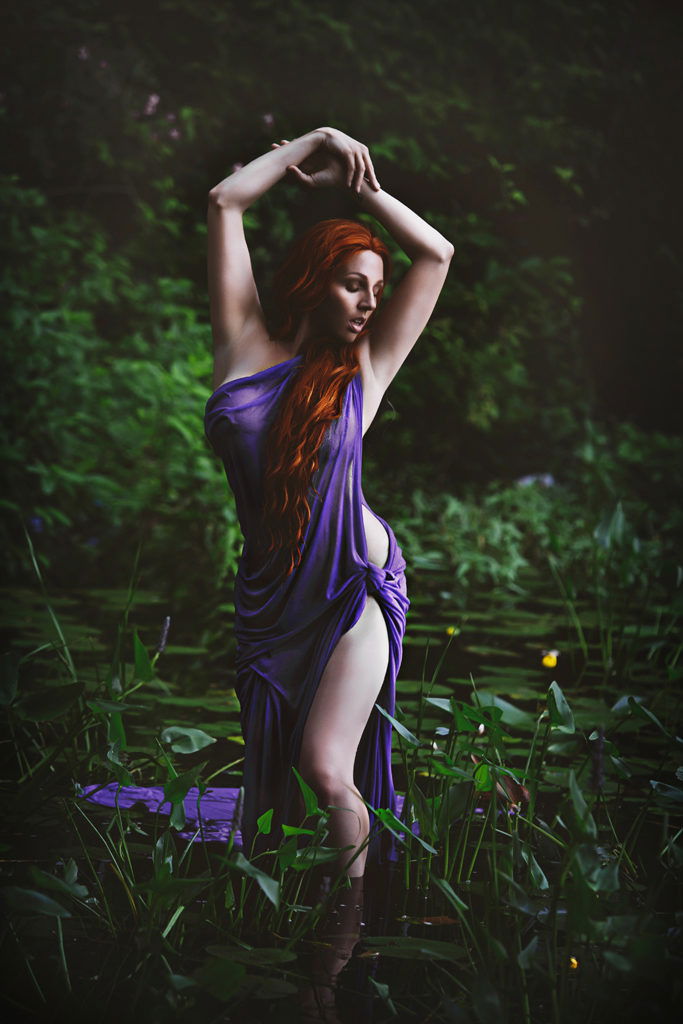
© Beth Claire
Conclusion: Shooting Boudoir Self Portraits
It doesn’t matter when you start or how many images you may get from your first boudoir self portrait photoshoot. You will gain a new respect for photography and your clients.
It opens your eyes to your shooting space, lighting, posing choices, and much more. Self-portrait boudoir photography can lead you to a whole new world of options for your boudoir photo business!

